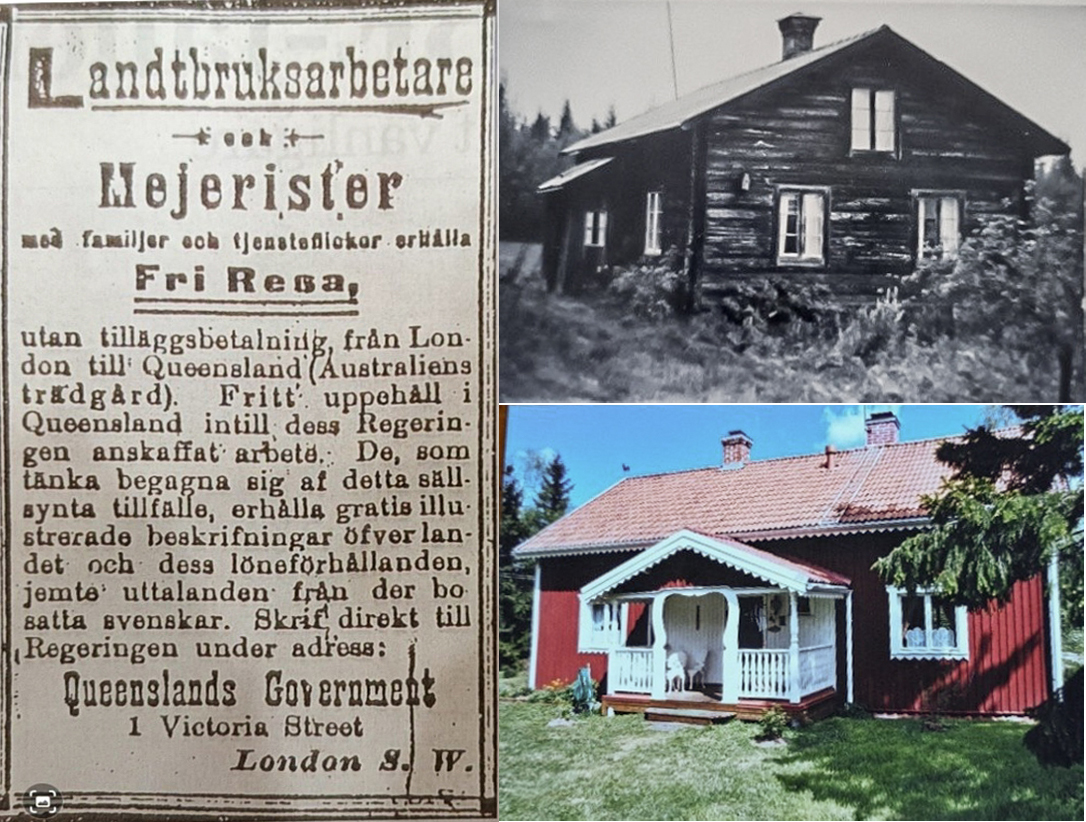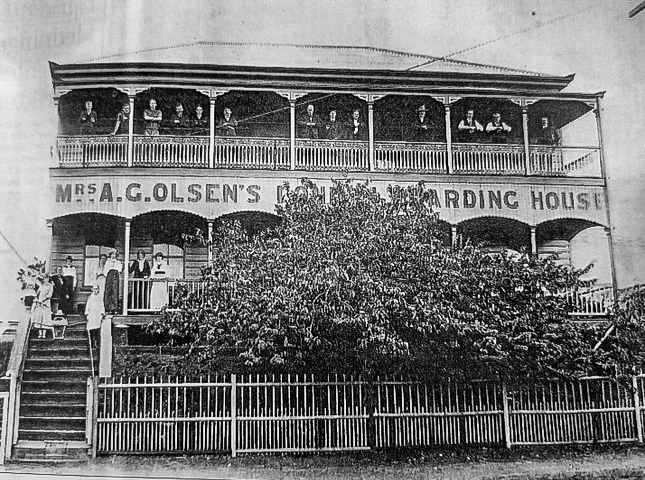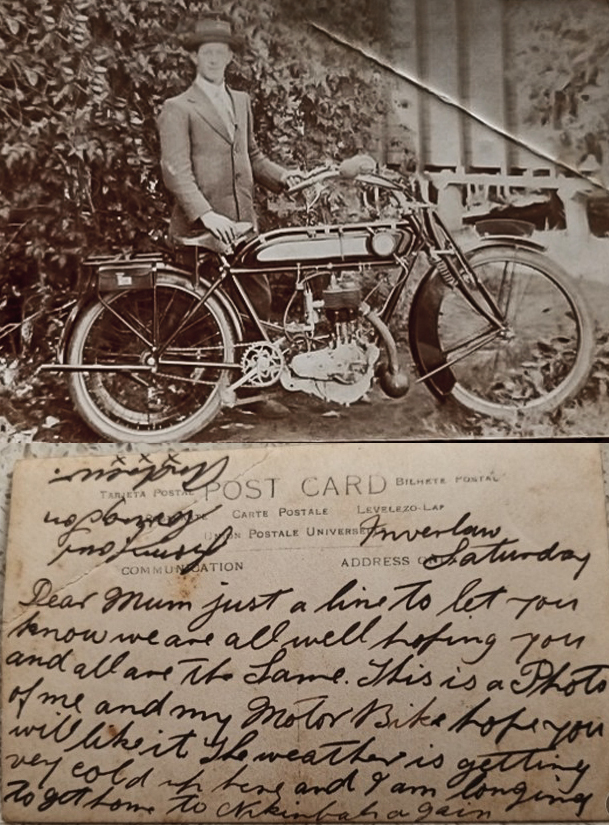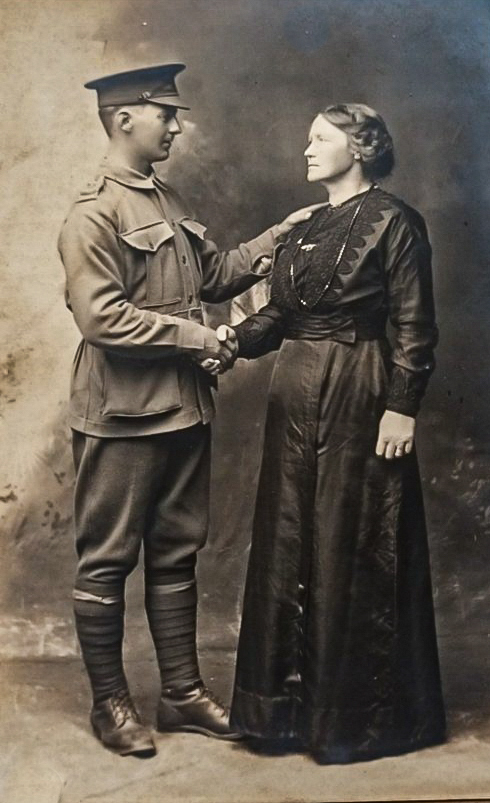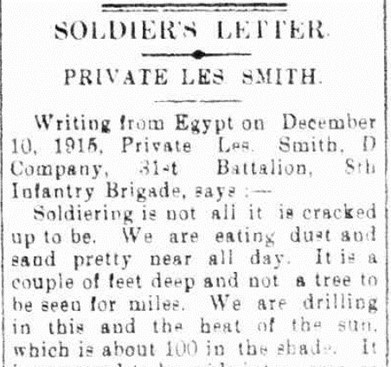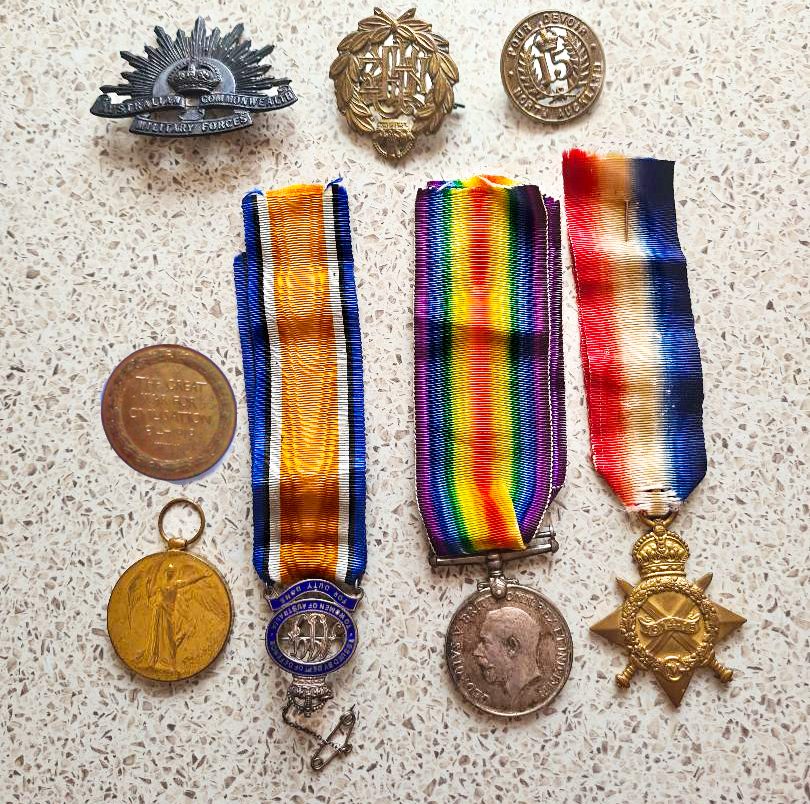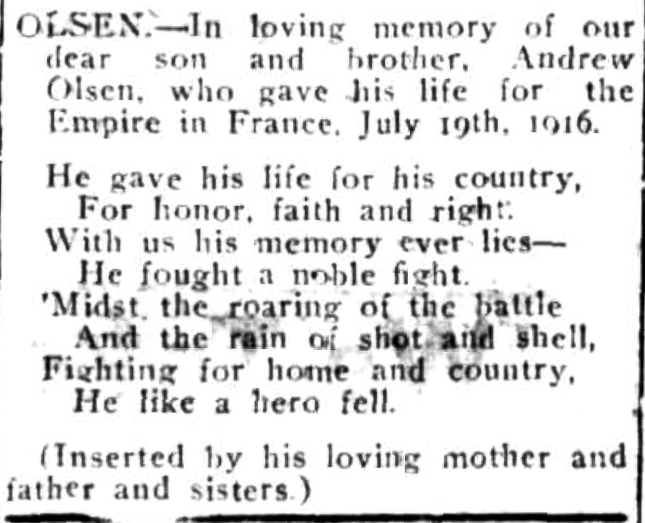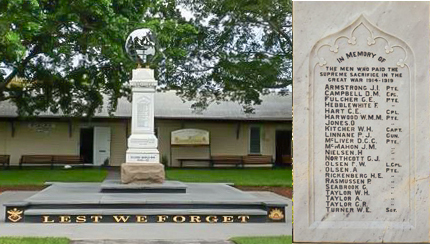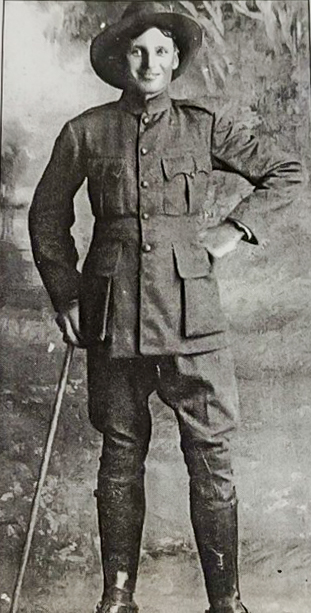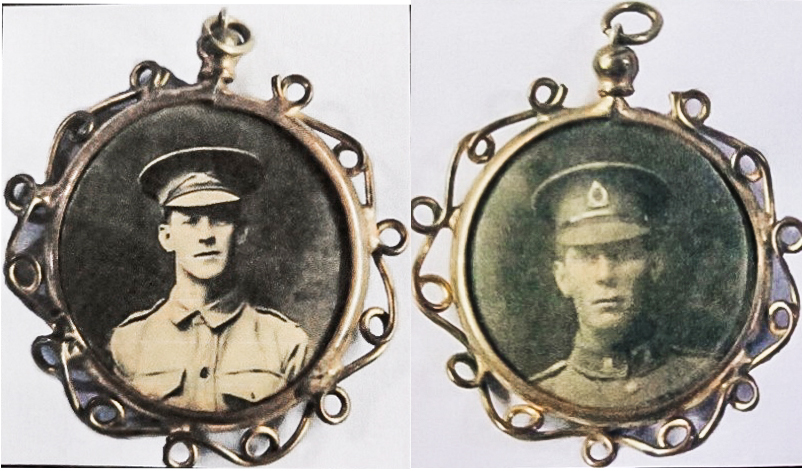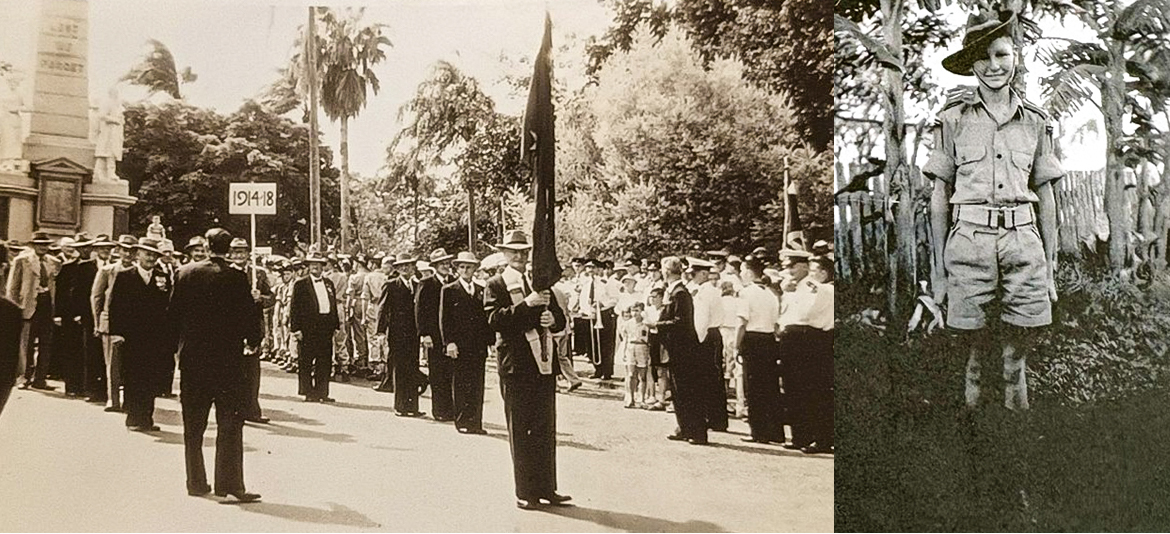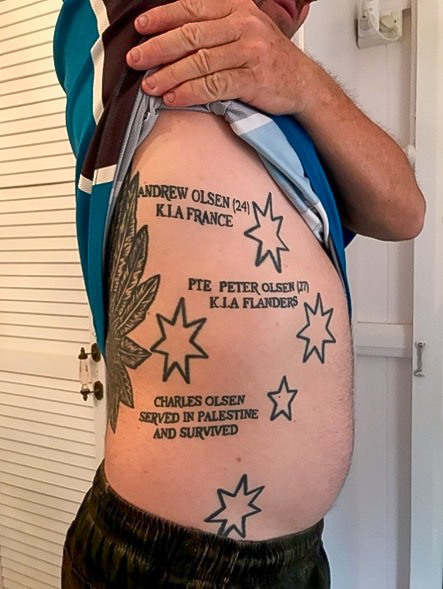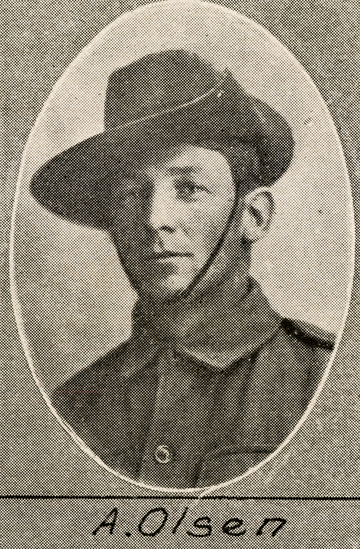
Andrew OLSEN
Eyes blue, Hair brown, Complexion fresh
ANDREW OLSEN – A Swedish Son at Fromelles
Can you help find Andrew?
Andrew Olsen’s body was never found after the Battle of Fromelles, and there are no records of his burial. A mass grave was found in 2008 at Fromelles, a grave the Germans dug for 250 Australian soldiers they recovered after the battle. As of 2024, 180 of these soldiers have been able to be identified via DNA testing.
Andrew may be among these remaining unidentified men. His family members have contributed DNA in hopes of being able to identify him, but we welcome all branches of his family to come forward as well, should there be any additional needs, especially those with roots in Jarvso, Sweden.See the DNA box at the end of the story for what we do know about his family.
If you know anything of contacts for Andrew, please contact the Fromelles Association.
With sincere gratitude for the input of the extended Olsen family
Early Life
Andrew Olsen was born Anders Olsson / Olson in Järvso, Gävleborg (now Hälsingland), Sweden on 25th November 1891. He was the fourth and youngest son of Anders Gustaf Olson (1854 - 1938) and Karin (Kathleen) Jonsdotter Olson (1863 - 1934). For the growing Olson family, 1899 was a watershed year. With already eight children to support and only a small farm, times were hard. Perhaps tempted by the persuasive announcements in the Ljusdal newspaper, with the promise of free passage and better opportunities in Queensland Australia, and government assistance to establish themselves; or perhaps driven to their wits' end by an ongoing feud with their difficult neighbour across the way, Anders and Karin decided to emigrate.
The day of their departure, with the horse-drawn dray packed high with the family and a few precious household goods, the neighbour was on his rooftop jubilantly waving a sheet to celebrate his luck that the Olsons were now on their way to the other side of the world. They were a group of 13 that left Sweden then London on the Duke of Portland on June 15 1899 - Anders, Karin, their eight children, Karin's son Johan from an earlier relationship, Anders' widowed sister Kristina and her son Adolf.
The voyage was arduous for a large family with young children, complicated by the fact that Karin was exhausted and in the third trimester of her pregnancy with their ninth child. Marta, one of the two-year-old twins, sadly died of sunstroke before reaching port and was buried at sea. A month later, on 16 August, the ship berthed at its destination - Brisbane, Queensland. From this point they moved to the Darling Downs near Warwick, 180 km west of Gold Coast, where daughter Helga was born on 20th October1899, followed by the home birth of Matilda on 6th August 1901 at Yangan.
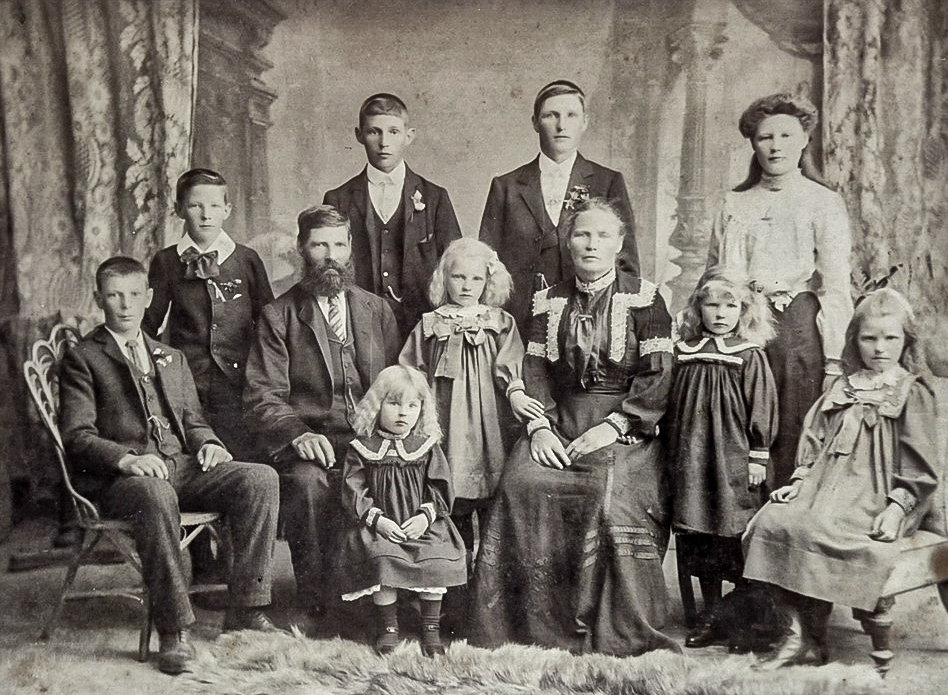
Back row (left to right): Anders (Andrew) KIA, Frederik Olaf, Charles Gustav, Anna Kristina
Front row (left to right): Peter William KIA, father Anders Gustav, Maria, mother Karin Jonsdotter, Helga, Karin.
Seated in front: Matilda
Family details:
- Carl (Charles Gustaf) Olsen (1886-1969), married Henrietta Georgina Barker
- Frederik (Olaf) Olsen (1887-1954), married Elizabeth Beck and settled in New Zealand
- Anna Kristina (Annie) Olsen (1888- 1960), married John Andrew Stewart in New Zealand
- Per Olaf (Peter William) Olsen (1890-1917), killed in action in Belgium
- Andrew (Anders ) Olsen (1891 – 1916), killed in action at Fromelles
- Karin Olsen (1895 – 1926), married John Edward Loveday
- Maria (known as Martha) Olsen (1897-1974), married August Nagel
- Marta Olsen (1897-1899), died on the voyage to Australia
- Helga (Hilgea, known as ‘Digger’) Olsen (1899-1979), married John Copp
- Matilda Olsen (1901-1992), married Joseph Walter Will
According to Andrew’s school admission records, he was enrolled as Anders Olson at the Yangan school in 1899, along with the older children, and then at the school at Danderoo just over eight kilometres away. But the Yangan area was only to be their temporary home. In the first of many moves, they soon left for New Zealand where they stayed for approximately eight years, certainly long enough for Matilda, the youngest, to begin her education and the older children to finish theirs. By this time the boys were working for the local council, looking after the horse stables, and Anders Gustaf was growing grain.
But Anders Gustaf had other plans. He had a dream to buy his own farm and grow sugar cane. So with the exception of Frederik, Annie, and Per Olof who all chose to stay permanently in New Zealand, the reduced family moved once again back to Australia; this time to the Nikenbah area near Pialba, Hervey Bay, which at the time, had a large supportive Scandinavian community of mainly Danish settlers and was in good cane growing country. The time at Nikenbah meant farm work for Anders, with his two sons working as labourers to help support the family.
Karin worked as a midwife for the district, being summoned out in her sulky at all hours to attend a birth and Helga and Matilda were sent off to school first at Dundowran, then at Nikenbah. By thrift and hard work the family finally settled for good in Maryborough around 1913-1914, with their surname now Anglicised to ‘Olsen’. Assisted by her daughters, Karin was running the London Boarding House in Wharf St Maryborough, with her name emblazoned over the front.
Anders purchased and was working ‘Melrose’, the farm at Tinana which he intended in the years to come to be his gift to Charles and Andrew and provide for their secure future. These years back in Queensland before the war, with security and independence, were probably the happiest in young Andrew’s life. While the family were still at Nikenbah Andrew appears to have travelled to other areas of the south east to buy a motor bike, proudly posing beside it for this photo to send back to his mother.
In December 1913 the Maryborough Chronicle reports that he was involved in a motor cycle collision in Maryborough while riding in the sidecar of a mate’s motor bike. Andrew and his friend escaped without serious injury but the rider of the other bike suffered a broken leg.
Source: ‘Motor Cycle Collision.’ (Maryborough chronicle, Wide Bay and Burnett Advertiser, 1 December 1913), p2.
The following photos tell the story of Andrew as a young man, by this time truly Australian, working hard but also enjoying his hobby of bare fist boxing, and time spent with his growing circle of friends as smart young men-about-town.
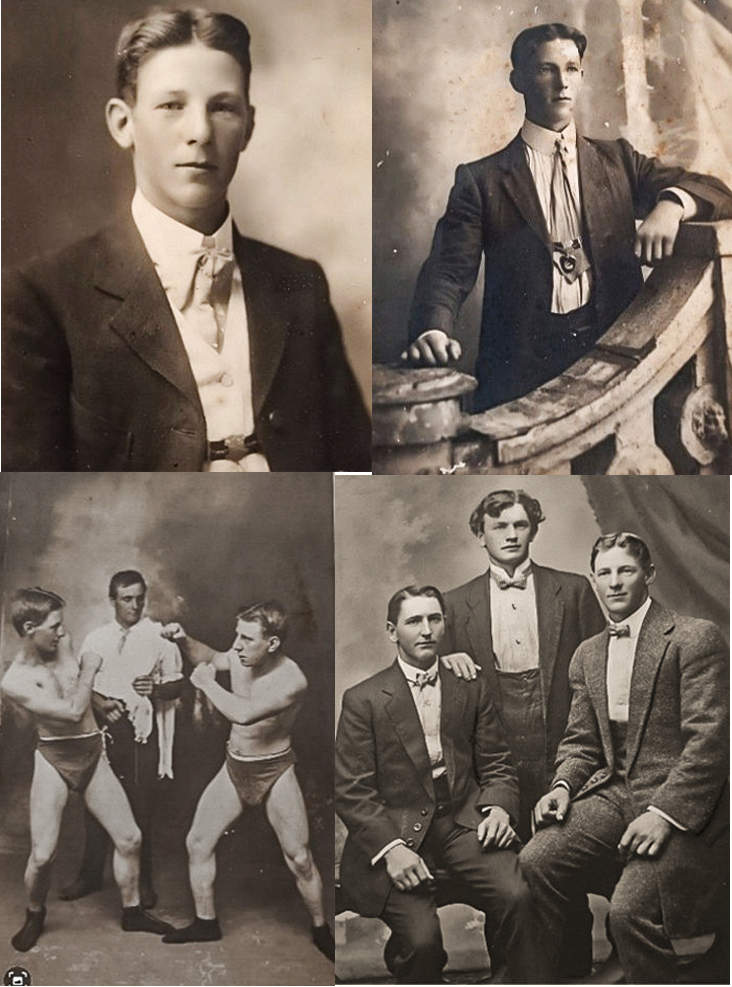
Bottom - Bare fist boxing and ‘Young men about town’ (Andrew – R)
The war changed all that.
Off to War
Andrew was one of three sons of Anders and Karin to fight in the Great War. He enlisted on 8 July 1915. However, he needed to be an Aussie, so (like many others who got ‘creative’ with their enlistment details in order to serve) he “appropriated” his younger sisters’ birthplace of Yangan, Queensland and his school as Pialba, echoing their schooling days in that area. He was accepted for service and posted to the 31st Battalion, B Company. Like others he was affirming his strong sense of belonging in this, his adopted country, barely a decade after settling here.
The 31st Battalion was formed with two companies from Queensland and two companies from Victoria. The Queenslanders’ initial training was at the Rifle Range Camp in Enoggera. All were joined in early October at Broadmeadows in Victoria. Before sailing from Melbourne on 9 November aboard the troopship Wandilla, the 991 soldiers of the 31st had been on parade in Melbourne in front of a good crowd.
The Minister for Defence, H.F. Pearce said:
“I do not think I have ever seen a finer body of men.”
The Wandilla docked at Port Suez exactly four weeks after leaving Melbourne. They were first sent to Serapeum to continue their training and to guard the Suez Canal from any potential threats posed by the Ottoman Army. Near the end of February, they moved to the large camp at Tel-el-Kebir , which was about 110 km northeast of Cairo. The 40,000 men in the camp were comprised of Gallipoli veterans and the thousands of reinforcements arriving regularly from Australia.
The 60 km trip must have been unpleasant, as it was reported that they were moved in “dirty horse trucks.”
Source - AWM4 23/48/7, 31st Battalion War Diaries, Feb 1916, page 5.
The next move was at the end of March, back to the Suez Canal at the Ferry Post and Duntroon Camps and then finally to Moascar at the end of May. The months passed in training and sightseeing, but by the time the 31st Battalion was transferred to France, the men were all heartily sick of Egypt. Private Les Smith’s (934) letter home pretty well sums it up.
On 15 June, the 31st Battalion began to make their way to the Western Front, first by train from Moascar to Alexandria and then sailing to Marseilles. A, B and D companies were aboard the troopship Hororata. After disembarking on 23 June, they were immediately boarded onto trains to Steenbeque and then marched to their camp at Morbecque, 35 km from Fleurbaix in northern France, arriving on 26 June. The battalion strength was 1019 soldiers.
The area near Fleurbaix was known as the “Nursery Sector” – a supposedly relatively quiet area where inexperienced Allied troops could learn the harsh realities of Western Front trench warfare against the Germans. But the quiet times and the training period did not last long. Training continued, now with how to handle poisonous gas included in their regimen. They began their move towards Fromelles on 8 July and by 11 July they were into the trenches for the first time.
The Battle of Fromelles
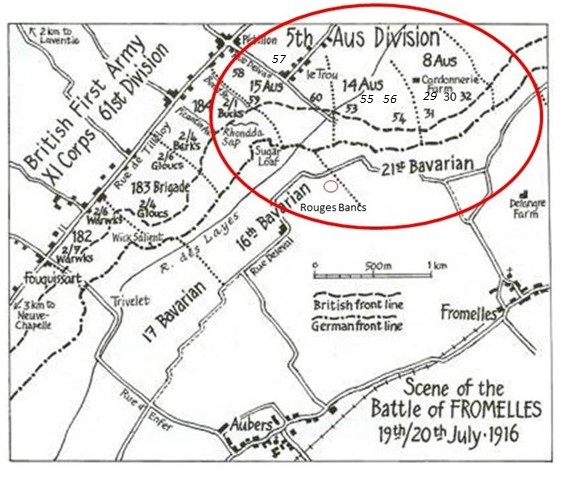
The overall plan was to use brigades from the Australian Fifth Division to conduct a diversionary assault on the German trenches at Fromelles. The main attack was planned for 17 July 1916, but bad weather caused it to be postponed. On the afternoon of 19 July, Andrew and the men of the 31st were back in the trenches, in position by 4.00 PM. Zero Hour for the advance was set for 5.45 PM. But the Germans had been observing the build-up for days and were well prepared:
“Just prior to launching the attack, the enemy bombardment was hellish, and it seemed as if they knew accurately the time set.”
The assault began at 5.58 PM. The battalion went forward in four waves: A and C Companies leading, followed by Andrew’s B Company and D Company in the third and fourth waves. As they crossed No Man’s Land they came under machine-gun fire from Delrangre Farm directly ahead and from emplacements on the left, with heavy artillery adding to the carnage. Despite these obstacles, by 6.30 PM the Australians had captured the German first-line trench system — known as Trench B — described as “practically a ditch with from 1 to 2 feet of mud and slush at the bottom.”
Source: AWM4 23/49/12, 32nd Battalion War Diaries, July 1916, p.11
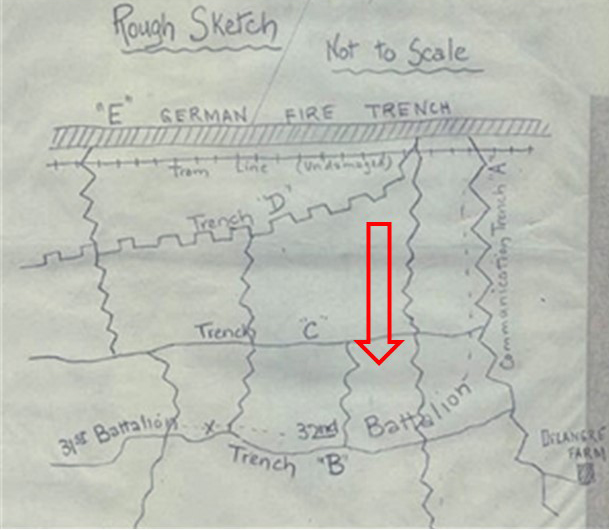
The success was short-lived. Their own artillery began falling short, causing heavy casualties among the Australians. By 8.30 PM the left flank was under intense bombardment and the 32nd Battalion beside them were ordered that “the trenches were to be held at all costs.”
Source - AWM4 23/49/12, 32nd Battalion War Diaries, July 1916, p.12
Through the night, fighting continued. The Australians pushed further forward beyond Trench B but were desperately short of grenades. They were hit by machine-gun fire from behind from Delrangre Farm and they wer getting shelled from both sides, caught between the enemy and their own supporting fire. At 4.00 AM on 20 July the Germans counter-attacked from the Australians’ left flank, bombing and re-occupying Trench A (map). With parts of the rear trench system (Trench E) left thinly held, the Germans were able to surround sections of the 31st.
At 5.30 AM, they attacked from both flanks in force with bombing parties. With only rifles and a handful of grenades left, the Australians were quickly overwhelmed:
“The enemy swarmed in and the retirement across No Mans’ Land resembled a shambles, the enemy artillery and machine guns doing deadly damage.”
By the end of 20 July, the battered remnants of the 31st had been forced back to their original lines. Of the 1,019 men who had sailed from Egypt only weeks earlier, the first reports listed 77 killed, 414 wounded, and 85 missing. The eventual total for the 31st was 162 were killed or died of wounds, of which 82 had no known grave. When Charles Bean, Australia’s official war historian, visited the battlefield two and a half years later, he still found a large quantity of bones, torn uniforms and Australian kit scattered across the ground.
The bravery of the 31st Battalion’s soldiers, including Andrew Olsen, was recognised by their commanders.
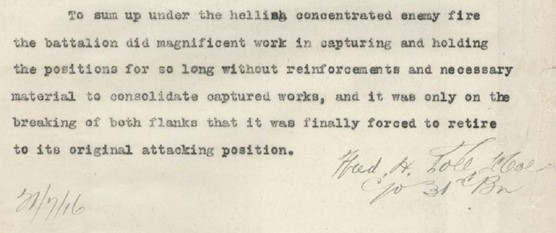
After the Battle
Andrew Olsen was killed in action, 19 July at Fromelles aged 24. For his family in Maryborough the news was devastating – three brothers had enlisted, and now Andrew, the youngest, was gone. His name appeared in casualty lists in local papers, and like many families, the Olsens endured months of uncertainty before receiving details of his death. Anders Gustaf’s letter to the War Office in his poignant, fractured English, full of pain reveals the family’s anguish at the wait.
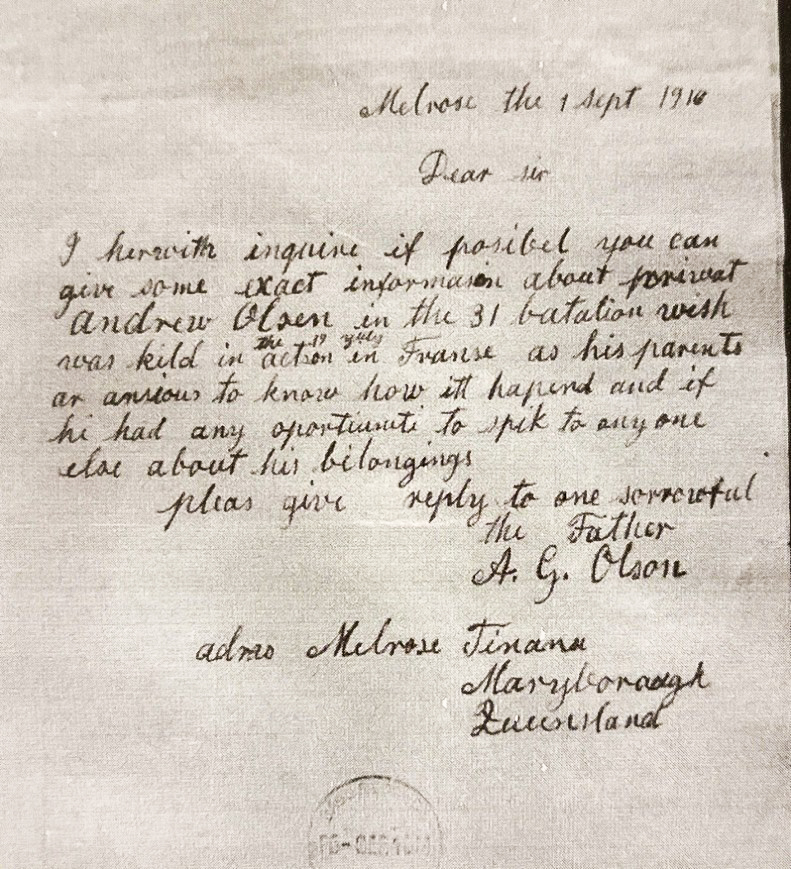
The Red Cross and the Army did undertake extensive efforts to find the missing, but with all the chaos from the battle, there are no reports of what happened to Andrew during the battle, he was “just” missing and was formally declared as having been killed in action on 19 July 1916. While Andrew’s body was never found, his records have an undated, handwritten note, “Buried at Fleurbaix”, with a general map reference of the battle area. Over 50 soldiers from the 31st have similar notes in their files, as well as soldiers in other battalions.
Andrew was awarded the 1914-15 Star Medal, the British War Medal, the Victory Medal, a Memorial Plaque and a Memorial Scroll.
On the anniversary of his death, the family placed a tribute in the newspaper.
With no resting place to visit, his family turned to community memorials and remembrance. Andrew’s sacrifice is honoured in Australia and New Zealand.
He is commemorated at:
- Australian War Memorial, Roll of Honour, Canberra, ACT
- Maryborough Queen’s Park War Memorial, Queensland
- Pialba War Memorial, Hervey Bay, Queensland
- V.C. Corner Australian Cemetery and Memorial, Fromelles, France
The Olsen Family at War – A Family Changed Forever
The Olsen family knew sacrifice more deeply than most immigrant families. Seventeen years after leaving their home country, Anders Gustaf and Karin had three of their sons in uniform, two of them never to return. Peter William Olsen (12/4059), two years older than Andrew, enlisted in the New Zealand Expeditionary Force in 1916. Posted to the 2nd Battalion, Auckland Regiment, he endured the mud and horror of Belgium. Peter was killed in action on 4 October 1917, during the Battle of Broodseinde, 27 years old. He is buried at Tyne Cot cemetery in Belgium.
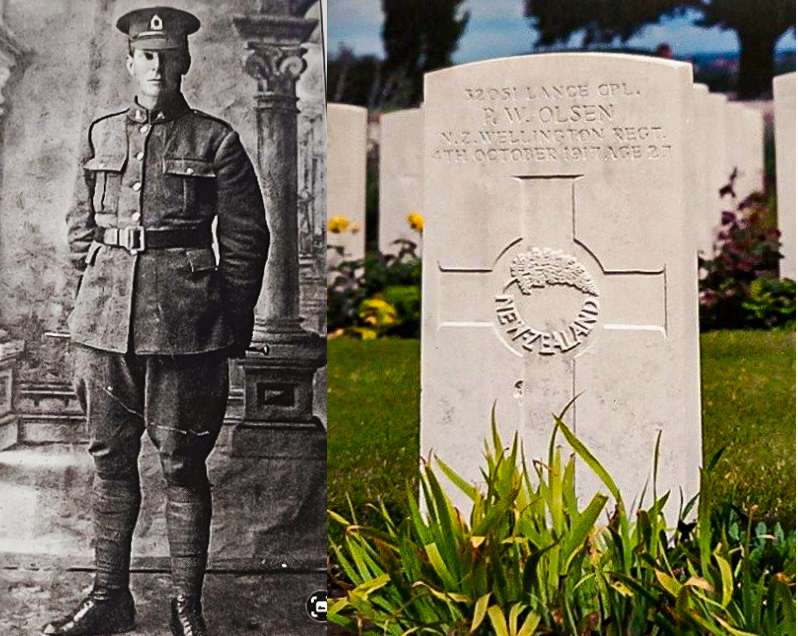
Charles Olsen, the eldest surviving son, had enlisted in May 1916 with the AIF, joining the 15th Battalion and he served with the Australian Light Horse in Palestine. Unlike Andrew and Peter, he did survive the war, returning to Queensland in 1919 and living until 1969.
For the rest of her life, Karin always wore a double sided locket around her neck with Andrew’s photo on one side and Peter’s on the reverse - her way of keeping her sons close to her.
A grand daughter remembers Anders Gustaf in the little house he and Karin lived in in Maryborough after Charles took over the farm:
“He would greet us at the door and take us straight through the house to the strawberry garden at the back. Grandma Olsen would always be sitting in another room in her rocking chair, dressed in black and wearing her locket around her neck. She always seemed sad. We rarely saw her.”
Present day family reflections
The memory of Andrew and Peter has always been with us. Family representation in the Anzac Day march has always been important to us in maintaining that memory. In 1958, Charles aged 72, with back ramrod straight as any young soldier, carried the flag and led the Maryborough procession wearing his brothers’ medals. In the same march, 15 year old son Barry was in the cadet squad bringing up the rear.
Sixty-one years later, aged 90, his daughter Thelma led the contingent for Legacy, and at the other end of the age continuum young Charles Gilchrist aged 9, great great grandson to Charles, with an almost overwhelming sense of responsibility, marched at Pialba, proudly wearing Peter William’s medals. Other family members in other towns have also marched through the years. Not to do so would be like allowing Andrew and Peter’s story to pass quietly into the general annals of history and no longer our own close family lore.
We are immensely grateful to our Swedish- Australian forbears and proud of their commitment and sacrifice. Their memory connects us, stiffens our backbone when the need arises and gives us the resolve to persevere. The exact sentiment is difficult to define but is best articulated, asserted, even shouted, three generations later by another Andrew – Andrew Butcher, great great grandson to Matilda, who bears the tribute on his chest.
Finding Andrew
Andrew’s remains were not recovered, he has no known grave. After the battle, the Germans recovered 250 Australian soldiers and placed them in a burial pit at Pheasant Wood. This grave was discovered in 2008 and since then efforts have been underway to identify these soldiers by DNA testing from family members. As of 2024, 180 of the soldiers have been identified, including 23 of the 82 unidentified soldiers from the 31st Battalion.
Andrew’s family members have contributed DNA in hopes of being able to identify him, but we welcome all branches of his family to come forward as well, should there be any additional needs, especially those with roots in Jarvso, Sweden. If you know anything of family contacts, please contact the Fromelles Association. We hope that one day Andrew will be named and honoured with a known grave.
Please visit Fromelles.info to follow the ongoing identification project and Andrew’s story.
DNA samples are being sought for family connections to
| Soldier | Andrew Olsen (1889–1916) | Killed in Action, 19 July 1916, Fromelles, France |
| Parents | Anders Gustaf Olsen (1854–1938) m. Karin (Kathleen) Jonsdotter (1863–1934) |
| Siblings | Carl (Charles Gustaf) (1886-1969), married Henrietta Georgina Barker | ||
| Frederik (Olaf) (1887-1954) married Elizabeth Beck | |||
| Anna Kristina (Annie (1888-1960), married John Andrew Stewart | |||
| Peter William (1891 – 1917) NZ KIA | |||
| Karin (1895 – 1926), married John Edward Loveday | |||
| Maria (known as Martha) (1897-1974) twin , married August Nagel | |||
| Marta Olsen (1897-1899) twin died on the voyage to Australia | |||
| Helga (Hilgea, known as ‘Digger’) (1899-1979) married John Copp | |||
| Matilda (1901-1992) married Joseph Walter Will | |||
| Grandparents | |||
| Paternal | Olof Olsson (1823–1903) m. Maria Caisa Eriksdotter (1824–1899) | ||
| Maternal | Jonas Jonsson (1826–1896) m. Anna Cajsa Johansdotter (1830–1904) |
Seeking DNA Donors

Contacts
(Contact: carla@fromelles.info or geoffrey@fromelles.info).
(Contact: army.uwc@defence.gov.au or phone 1800 019 090).
Donations
If you are able, please contribute to the upkeep of this resource.
(Contact: bill@fromelles.info ).
